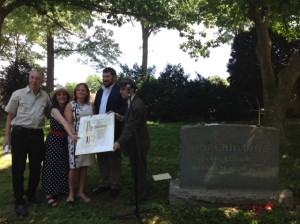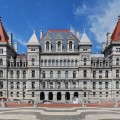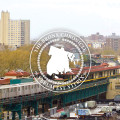
NYC Council Speaker Hon. Melissa Mark-Viverito (center) surrounded by Forum members (l-r) Gerald Meyer, LuLu LoLo Pascale, Adam Meyer, and Roberto Ragone. (c/o Omesh Persaud)
Guest Piece written by Morgan Powell
The occasion of a major American progressive’s memorial on Saturday, August 9 compelled me to visit some places that remain from his times. Come walk with me. We’ll also recognize others buried within Woodlawn Cemetery who were similar in their ambitions for an expansive democracy. You are about to enter the world Vito Marcantonio offers me–even if I was born almost twenty years after he expired.
United States Congressman Marcantonio (1902-1954) simultaneously served America’s largest Little Italy and biggest continental Puerto Rican enclave with a significant constituency of African-Americans through the Great Depression, World War II, and early Cold War years (1934-1936 and 1938-1950). He exemplified a conscience, legal deftness, and administrative fluency for government in the best interests of blue-collar America. The Vito Marcantonio Forum (VMF), organizer of the aforementioned commemoration, has gone far to re-establish his visibility . This twentieth century people’s politician had a legislative vision and success record that demand to be revisited as similar issues re-emerge in American public life! The VMF’s website, events, and on-line videos serve to bring “Marc” to life including a taped panel discussion at the Left Form.
Walking San Vito’s Harlem
With Gil Fagiani’s Litany of San Vito poem in mind, I began a stroll to sites that would have been familiar to “Marc” (as he was sometimes affectionately called). Some thought him a saint (San means saint in Spanish and Italian).
Beginning at Malcolm X Boulevard (Lenox Avenue), I walked east on 116th Street through a canyon of newer buildings where a vaudeville theater district (see buildings at 37 and 18 West 116th Street) once catered to the ethnic New York of Marc’s childhood. My first stop was Lucky Corner where that young lawyer conducted the attentions of his mentor’s voter base. Marc made this aptly named crossroads at Lexington Avenue and 116th Street a crucial political rallying point for his predecessor in Congress who went on to become the Big Apple’s stellar New Deal-era mayor, Fiorello LaGuardia. Lucky Corner was Marcantonio’s to command when he too ascended to LaGuardia’s former elected office in the U.S. House of Representatives.
The Thomas Jefferson Houses was my next stop. This New York City Housing Authority (NYCHA) development replaced Marc’s childhood home. He grew up at 325 East 112th Street where many buildings across from his still stand. Walking along this development’s northern edge on East 115th Street, the low-rise townhouse and tenement scene on the north side of the street contrasts starkly with much taller NYCHA buildings on the south. Marc would have seen this early 1950s towers-in-a-park residence replace familiar streets and homes although it opened for occupancy shorty after he passed away. Perhaps it’s fitting that low cost modern housing for the masses–which he and LaGuardia advocated–would succeed his own former address. My next stop explored WPA-era improvements to Italian Harlem’s only public park across the street on 1st Avenue.
Thomas Jefferson Park, once graced by a large children’s vegetable garden, was already an evolving experiment in good government in Marc’s day. Social reformers had helped establish this park in the same decade of his birth. New municapally-operated green spaces sited within working class districts across America where an expanding civic priority in cities where the settlement house movement and the profession of social work promoted European-immigrants’ well-being. During Marc’s first term representing East Harlem, the pool and recreation center, that continue to serve thousands today, opened! It was hailed as “the last word in engineering, hygiene, and construction.”
Benjamin Franklin High School adjoins Jefferson Park along the FDR Drive, a roadway named for the “President who put America back to work” in the 1930s and 1940s. Public education pioneer and Marcantonio mentor Leonard Covello served as its first principal. This building was constructed, after long advocacy, in 1940 and 1941. At that time, Federal social spending was being subverted by escalating military appropriations as America entered World War II. True to New Deal optimism, this neo-classical brick and limestone building is a people’s palace of art and amenity. For example, the large auditorium situated immediately inside its colonnaded main entrance boasts generous seating appropriate for both school programming and civic affairs for different types of audiences. Over time, the uses of this carefully-designed interior public space have come to form a history of its own.
Our Lady of Mount Carmel Roman Catholic Church (448 East 116th Street) presents a rusticated pale stone facade on 115th St. just steps from the school. I entered Italian Harlem’s parish church and was impressed by how richly ornamented it was. There, Catholic narratives are interpreted in ceiling frescoes, stained glass windows, low-relief sculpture, carved marble altars, and life-sized dioramas in niches. As my eyes adjusted to the sacred light pouring in from all sides, I traced a series of medallions positioned between windows and elsewhere. They depict fourteen scenes in the life of Jesus including: “The cross is laid on Jesus,” “Jesus is stripped of his garments,” “Jesus consoles the women,” “Jesus dies on the cross,” and “Jesus is laid in the tomb.” I contemplated San Vito coming under FBI scrutiny, San Vito enduring the Wilson-Pacula Act of 1947, San Vito defending American leftists while steering social spending toward the most vulnerable, San Vito dead on Broadway, and San Vito’s burial sixty years ago. Wondering what support he enjoyed in life, I next walked to his wife’s (Miriam Sanders) former job where, among other things, she ran the nursery school.
LaGuardia Memorial House, once called Haarlem House though originally Home Garden Settlement, (307 East 116th Street) provides a very visible landmark to Marc’s time on 116th Street because both his final home (231 East 116th St.) and congressional district office (247 East 116th St.) further west remain-at the time of this writing-unsigned. This social services organization now lives at the base of a 1960s seniors tower within a busy commercial corridor dominated by low-rise prewar darker-toned structures. In the 1920s and early 1930s, Marc worked in an earlier building then called Haarlem House on tenants’ rights, immigration, education, and other issues. According to Vito Marcantonio: Radical Politician, 1902-1954 by Gerald Meyer, Marc “…helped to perpetuate Haarlem House as a neighborhood forum for liberal ideas and as a center for community organizing.” This brief tour of Marc’s Harlem helped me see where and what he stood for. As I took the subway home, my thoughts migrated to Marcantonio’s Bronx resting place and other American progressives at Woodlawn Cemetery worth visiting.
While Woodlawn Cemetery suffers from high turnover among office staff and poor labor relations with staff maintenance workers according to news reports in recent years, it is blessed with dedicated, informed, and generous staff and volunteers in the Woodlawn Conservancy. Susan Olsen, and colleagues, have been leading memorable tours for over a decade there. Their on-line, print, and archive resources can help you locate major American figures like labor and civil rights advocate Hubert Harrison, women’s rights champion Elizabeth Cady Stanton, humanist Herman Melville, peace negotiator par excellence Dr. Ralph Bunche, New Deal-era mayor Fiorello LaGuardia, and cultural ambassadors Bricktop and Countee Cullen among many others.
About the Author
Morgan Powell founded Bronx River Sankofa in 2011 as a spin-off from the Bronx African-American History Project (founded in 2003). He has used the Project’s methods of combining oral history and classical scholarship to assemble an inspiring and useful history of Bronx African-Americans. Beyond the thousands reached by his research in televised interviews and walking tours as well as published writing at Outdoor Afro, Sakofa once met over 1,400 members of the public in power point talks and walking tours. The Honorable Marcantonio first became a specific interest of Sankofa when it was learned in 2014 Marc had mentored the Bronx social reformer Evelina Antonetty. Antonetty was featured in Bronx River Sankofa’s very first self-published blog and we are happy to expand that research with this introduction to a related great American.
Click on this sentence to enjoy additional memorial photos by Matt Foglino.
Bronx Chronicle article on the commemoration.
Oggi America article on the commemoration.

















Follow Us